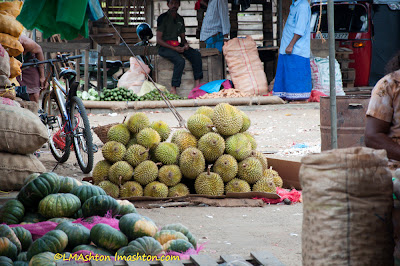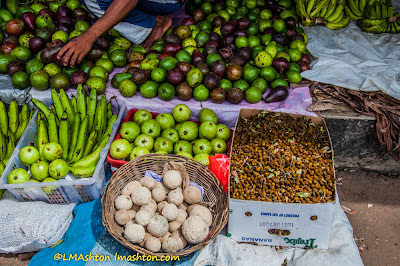This is a continuation of the last post on the <a href="http://srilanka.laurieashton.com/2013/06/kurunegala-sunday-market/">Kurunegala Sunday market</a>.

|
| From Sri Lanka – Kurunegala Market |
Pumpkins and durians.
Pumpkins are commonly eaten throughout the year in Sri Lanka, not just at Thanksgiving/Halloween/Christmas. They grown year round. And they're a much smaller variety, too. The ones you see in this picture are the common size of pumpkins in Sri Lanka. My mother in law cooks them, skin and all, as a curry.
Pumpkin is also made into a candy sort of like ginger candy - it's boiled in a sugar syrup until it's absorbed as much sugar as it can. Then it's dried out and then rolled in sugar crystals.
Durian... Ah, durian! You either love it or you hate it, or so pretty much everyone says. I've not had durian itself, only durian cake, which I neither loved nor hated. Go figure.

|
| From Sri Lanka – Kurunegala Market |
Green beans in the bag. Gotakola to the right with guavas behind that. On the left, avocados and bananas. Always bananas.

|
| From Sri Lanka – Kurunegala Market |
In the front round basket, wood apple. It's called wood apple because the outside is like wood and has to be broken into. Literally. You have to smash it.
Behind that, bananas, guava, and velvet tamarind. The velvet tamarind are called that because the outside bit is fuzzy like velvet, but the inside fruit tastes like tamarind.
Behind that are avocados. Avocados are treated like a fruit and are eaten in sweet drinks or with sugar/sweetened condensed milk added. Avocados eaten as a savory like guacamole is unheard of - and the Sri Lankans who I talked to about guacamole looked at me like I was an alien. :D

|
| From Sri Lanka – Kurunegala Market |
In the very front, the burgundy-ish round sticks are sugar cane. You can sort of see the pineapple on the floor to the right of the sugar cane.
The purple fruit above that are mangosteens. Ah, mangosteens! SO delicious!
If you ever get the chance to eat a mangosteen, do. You have to break in from the bottom - push in from the sides until it puckers and splits, then pull apart. You want the white flesh inside. But if you see green or yellow, it's bad, and sadness ensues. If you get the chance, if you're in a country where these grow, buy a dozen per person, then eat them quickly because they'll be gone before you know it. I know of what I'm talking about. :)
Papaya beside the mangosteen, then oranges, pomegranates, and more papaya. The clay pots contain curd, which is a dairy product like yoghurt but made from water buffalo milk, which is much fattier than cows milk. Delicious with jaggery.
Apples and oranges behind that.

|
| From Sri Lanka – Kurunegala Market |
On the left, the mostly red with bits of yellow fruit that looks like it has spikes are the rambutan. Which are sometimes depicted as alient fruit, like in the scifi show Defiance. That, and mangosteen and dragon fruit. Not alien. Just delicious. But I digresss.
To the right of the rambutan are stone apples - those are the tan-colored round things. Called stone apples because the outer rind really is like stone. My mother in law smashes it against our tile floor to open it, and I wonder what's going to win, the stone apple or the tile. Happily, the tile didn't break.
The white spheres beside the stone apples are wood apples. Not as hard on the outside as stone apples. But still, fruit on the inside just like stone apples.
Then mangosteens to the right of those. Seriously, mangosteens really are that lovely. Really.
Just behind the rambutan, you see those small purple spheres that look like they might be cherries? They're not. They're <a href="http://en.wikipedia.org/wiki/Flacourtia_indica">uguressa</a>, which are also called Indian plums.

|
| From Sri Lanka – Kurunegala Market |
Another view of the market. The bags on the left hand side that look like they're filled with beach balls? Watermelons. The watermelons that we get in Sri Lanka tend to be round and smaller than a basketball or volleyball, so personal sized for me. :P You can see watermelons on the right hand side near the front just behind some large boxes

|
| From Sri Lanka – Kurunegala Market |
There. A closer look at the watermelons in the bags with bunches of bananas behind them. I tell you, bananas are eaten by the tonne here.

|
| From Sri Lanka – Kurunegala Market |
Clay cooking vessels. The round pots can be seasoned with shredded coconut (always freshly shredded in Sri Lanka) or with coconut oil over a fire, then cooked in - that's traditional. On the left, you see the clay pots that look like they're growing an arm out the bottom? You feed the wood into the top of the arm, which reaches the fire in the bottom of the stove, and you put your cooking pot on top. Because not everyone can afford to use gas, which usually comes in cylinders much like propane tanks. (It's not common to have gas lines to your house. Not common at all.) And almost no stoves in Sri Lanka are electricity, and not everyone has electricity anyway.
